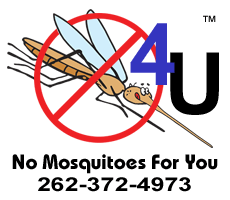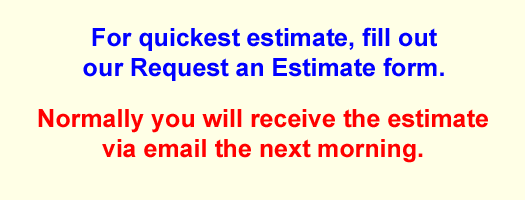 |
Japanese Beetle Control |
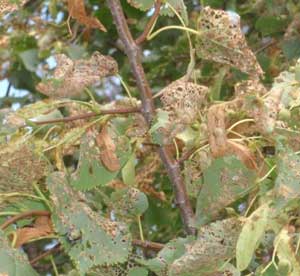 |
|
How do you know if you have a Japanese Beetle problem? The Japanese beetle is a small iridescent copper and green beetle. It’s fairly easy to spot in your garden – you’ll see the destruction in the leaves and petals of your plants. It can take longer to see the damage to trees, as beetles typically start at the top of a tree and work down. Japanese Beetles eat leaf tissue, but not leaf veins, leaving behind a lacy-looking leaf skeleton. These leaves soon die, causing destruction throughout your yard. Japanese Beetles are not picky eaters. They have been known to feed on over 300 species of broad-leaved plants – and have no natural predators in the U.S. Once a Japanese beetle lands on a plant or tree and finds the taste to its liking, it releases a chemical into the air that summons every hungry Japanese Beetle in the area to come and join the feast. |
||
![]()
The Japanese Beetle traps you can buy in the store attract more beetles much in the same way. Unfortunately, they only trap 70-80% of the beetles they attract, so they really do more harm than good. Seeing all of the beetles in the trap makes you feel like it is doing a good job, but remember that 20-30% of the beetles that were attracted by the trap are eating your leaves and flowers instead of going in the trap.
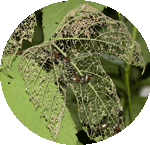 |
 |
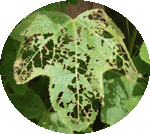 |
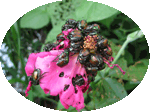 |
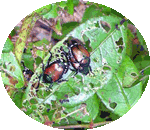 |
Japanese Beetles fly up to a half mile to find food, so it is important that we not only kill the beetles that are in your yard at the time of treatment, but also kill the beetles that will enter your yard long after the treatment is done.
![]()
Our treatment effectively eliminates Japanese Beetles for up to 60 days
We spray a liquid insecticide on the trees and plants in affected areas of your yard. This insecticide will leave an invisible residue everywhere we spray, which will kill the Japanese Beetles when they come in contact with it. If we have no rain, this residue will last about 60 days, but here in Wisconsin, the average is about 6 weeks. Once dry, the treatment is safe for people and pets. It is non-staining, odorless, and is EPA-approved for use in commercial, residential and public places.
Since the adults usually emerge around mid-June, the best time to treat for them is early- to mid-June and then again about 6 weeks later. By having problem areas of your yard treated early, you will be able to keep these pests from damaging your plants and trees. If you didn't get a treatment prior to their invasion, our treatment is still very effective in eliminating the beetles before they do any more damage. Keep in mind that the beetle population in your yard will increase if left untreated.
![]()
Here is what you can expect from our service
The Japanese Beetle treatment will kill the beetles that are present at the time of the treatment, plus will kill the beetles landing on the treated areas for about 6 weeks after the treatment. If we have a period of above average rainfall, the treatment will last a little shorter period of time (below average rainfall and it will last longer). You will still have beetles entering your yard as they look for food; however, they will die shortly after contacting the treated surfaces, so you won't have continued damage.
![]()
Great discounts when done along with a mosquito control treatment
We use the same insecticide to control mosquitoes, and when spraying for mosquitoes, we spray some of the same areas that we spray with our Japanese Beetle control. For this reason, we can offer substantial discounts when we do your Japanese Beetle treatment at the same time as the mosquito control.
![]()
![]()
Areas we serve:
Addison -
Alderley -
Allenton -
Ashippun -
Bayside -
Big Bend -
Boltonville -
Brookfield -
Brown Deer -
Butler -
Caldwell -
Cedar Creek -
Cedar Lake
Cedarburg -
Cheeseville -
Chenequa -
Colgate -
Concord -
Delafield -
Dousman -
Eagle -
Fillmore -
Fox Point -
Franklin -
Fredonia -
Genesee
Genesee Depot -
Germantown -
Glendale -
Grafton -
Hales Corners -
Hartford -
Hartland -
Herman Center -
Hubertus -
Huilsburg -
Hustisford
Iron Ridge -
Ixonia -
Jackson -
Jericho -
Kewaskum -
Kohlsville -
Lac La Belle -
Lakefield -
Lannon -
Lebanon -
Lisbon -
Mayfield -
Menomonee
Falls
Mequon -
Merton -
Milwaukee -
Monches -
Monterey -
Mukwanago -
Muskego -
Nashotah -
Neda -
Neosho -
New Berlin -
Newburg -
North Lake
North Prairie -
Oak Hill -
Oconomowoc -
Oconomowoc
Lake -
Okauchee -
Okauchee Lake -
Ottawa -
Pewaukee -
Pike Lake -
Port Washington
Potter Lake -
Richfield -
Rome -
Rubicon -
Saukville -
Saylesville -
Shorewood -
Slabtown -
Slinger -
St Anthony -
Stonebank -
Sugar Island
Sullivan -
Sussex -
Thiensville -
Thompson -
Tichigan -
Vernon -
Wales -
Washington
County -
Waterville -
Waubeka -
Waukesha -
Waukesha County
Wauwatosa -
Wayne -
West Allis -
West Bend -
Whitefish Bay -
Wind Lake -
Wisconsin -
Woodland
Japanese Beetle Control, Japanese Beetle Spraying, Japanese Beetle Extermination, Wisconsin, Get rid of Japanese Beetles, kill Japanese Beetles, green and copper beetle, lacy leaves, hollyhocks with lacy leaves, what is eating my hollyhocks, what is eating my roses, lacy leaves on roses, leaves look like lace, leaf looks like lace, what is eating my tomato plant, lacy leaves on tomato plant
![]()
